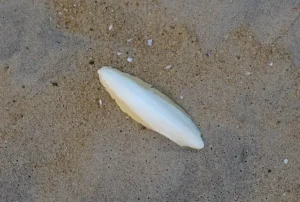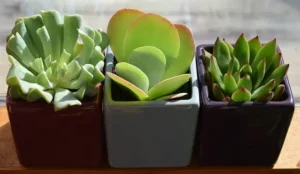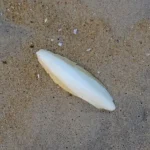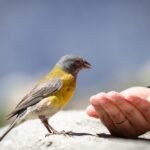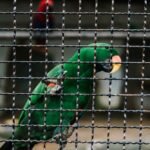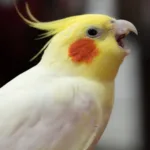A parrot’s beak is composed of the same protein that makes up our fingernails, called keratin and it continues to grow throughout its life. Parrots use their beaks for a variety of challenging tasks such as cracking hard foods, climbing, and exploring, which usually leads to wear over time.
As a parrot uses its beak for various activities, the outer keratin layer wears down. To make up for the natural wear and tear, the beak continually grows new material underneath the outer layer. This makes the visible part of the beak appear flaky or like it’s peeling off.
A parrot’s beak naturally has a slightly flaky look and in most cases, you don’t need to worry about it. You will almost never find a beak that is perfectly smooth and even. Some parrots, like Cockatoos, have a powdery residue on their beaks, however excessive peeling or dry flakes should be carefully looked at.
Quick Navigation
What Does A Healthy Parrot Beak Look Like?
Beak peeing is perfectly normal in parrots. Even some of the most extreme-looking cases might just be due to excessive rubbing of the beak. Parrots like to rub their beaks on different surfaces to keep them trimmed. The following are the characteristics of a healthy beak:
Symmetrical
A parrot’s beak should be uniform, meaning it has a consistent shape and thickness along its length. Over time, it may change slightly but abnormalities in shape, size, or growth can pose problems for the parrot.
Smooth
A healthy beak should have balanced proportions from left to right. It should be smooth and free from any rough textures, bumps, or cracks.
No Discoloration
A healthy parrot beak should have a uniform color all through the surface. Discoloration or dark spots on the beak usually indicate nutritional deficiencies. The bear may return to its normal color if its nutritional needs are properly met.
Correct Length
Different parrot species have different beak lengths. It is important to make sure that your parrot’s beak stays within its average size. A healthy beak will have upper and lower parts that align correctly when it is the proper length.
Perfectly Aligned
In addition to the correct length, the upper beak should align properly with the lower beak. Parrots have movable upper and lower jaws that enable them to hold and manipulate objects.
What Does Beak Peeling Look Like?
Beak peeling in parrots looks like small, thin cracks or flaky beak material coming off of the beak. Beak peeling is usually around the entire surface of the beak but the flaking can be more prominent in some areas.
These areas may look rough and uneven but will show a fresh, smooth layer of keratin underneath. The sloughing off of the old keratin layer happens gradually over time, and it’s a natural part of a parrot’s beak growth.


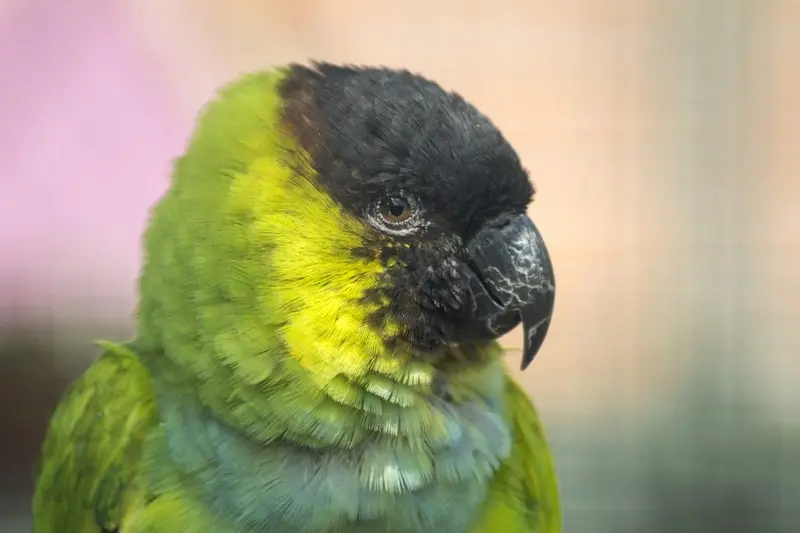

Other Reasons For Flaky Beaks In Parrots
Flaky beaks in parrots can occur due to various reasons aside from the normal replacement of the keratin layer. Below are some of the reasons why your parrot’s beak may be peeling:
Nutritional Deficiencies
Parrots that are on poor or unbalanced diets often suffer from nutritional deficiencies. This can cause the keratin layer on the beak surface to shed faster. It also leads to softened beaks because the body does not have adequate resources to supply the proper formation of beak material.
This condition occurs due to a calcium and vitamin D deficiency. The parrot may recover from this situation if the diet is corrected though, you should consult a vet to provide a detailed meal plan for your parrot’s speedy recovery.
Infections
Parrots can develop bacterial and fungal infections from poor hygiene, stale water, bad food, and a general lack of cleanliness in the household. These infections can affect different parts of the body including the beak.
When a parrot’s beak becomes infected, it can cause discomfort and itching, leading to the parrot rubbing its beak excessively on hard surfaces. Sinus infections and allergies can also make the parrot rub its beak on objects.
However, it can also be the result of a more serious infection. Psittacine beak and feather disease (PBFD) is a highly infectious viral disease that affects parrots.
According to the MSD Veterinary Manual, parrots infected with PBFD show physical symptoms such as beak lesions and feather abnormalities. If you notice any unusual growth on your parrot’s beak, you should get it checked out by an avian vet.
Scaly Mites
If the flakes on your parrot’s beak look more like scales and can be seen in other areas of the body as well, it may be due to scaly mites infestation. It is a type of infection that affects the parrot’s foot, legs, face, and beak.
These mites belong to a group called Knemidokoptes and they are parasitic, which means they live off your bird’s skin. This disease commonly affects small birds like budgerigars but it is also seen in other parrots.
Trauma
While a parrot’s beak is quite strong, it can sustain wear from regular use. If the parrot hits its beak hard enough against an object it may even sustain damage.
Parrots sometimes like to bang their beaks against objects which can lead to peeling at the tip of the beak. While it is not something to worry about, you should regularly check your parrot’s beak for any kind of injury.
Parrots have blood vessels and nerves inside their beak, which means injuries and impact can cause pain and discomfort and prevent them from eating or using their beak for any other purpose.
How To Care For Your Parrot’s Beak?
Although beak peeling is not a concerning situation, it is always good to keep your parrot’s beak in the best shape. The beak is a vital tool for parrots and requires care and maintenance from time to time. Parrots are quite self-reliant when it comes to taking care of themselves, but in certain cases, it helps to assist them.
Balanced And Healthy Diet
The parrot’s beak is covered with a layer of keratin – a type of protein that grows continually. It makes up the hard covering over the bone and gives the beak a vibrant appearance.
So it’s important to provide your parrot with enough protein in its diet to promote keratin production.
Providing your parrot with a nutritious and balanced diet goes a long way for its beak health. In addition to high-quality pellets, incorporate some green vegetables in their meals along with fruits and nuts.
Nuts can be a great source of protein but they are also high in fat, so offer in moderation. Also, foods that are high in Vitamin-A and carotenoids can help maintain the glossy look of their beaks.
Foods rich in carotenoids for parrots include:
- Carrots
- Sweet potatoes
- Eggs
Abrasive Chew Toys
A healthy beak needs to stay in shape and for that, your parrot should be able to exercise its beak on different objects. You should always have an assortment of chew toys in your parrot’s cage. These would include some hard toys, a cuttlebone of course, a wooden perch, and Balsa or other wooden blocks.
The rubbing action that parrots are so inclined to do acts like a natural manicure for their beaks, ensuring they stay the perfect length, shape, and alignment.
Safe Environment
It is not uncommon for parrots to occasionally bump into things as they are exploring their environment. While most of the time such incidents do not cause any harm, they can possibly injure themselves if they crash land too harshly.
Of course, it is not possible to stay with your bird all the time or monitor their activities, but most of these accidents happen when the parrot is out of its cage. So it would be prudent if you could supervise their out-of-cage time.
You should also ensure that the surroundings are clear of any objects or household items that may potentially injure the parrot. Offer safe toys that are the right size for your parrot. Make sure those toys don’t have small parts or sharp edges that could hurt your parrot if it chooses to rub its beak against it.
Regular Beak Check-Ups
It is normal to see some abrasion on your parrot’s beak however, you should keep an eye out for excessive beak peeling. Sometimes it can happen because of unhealthy habits like rubbing the beak excessively on things. Other times, it may be an injury or trauma to the beak.

